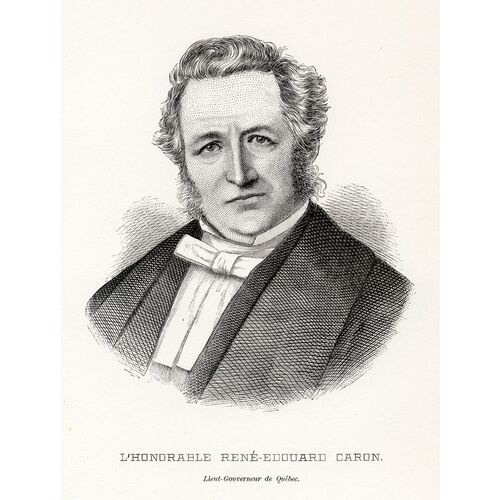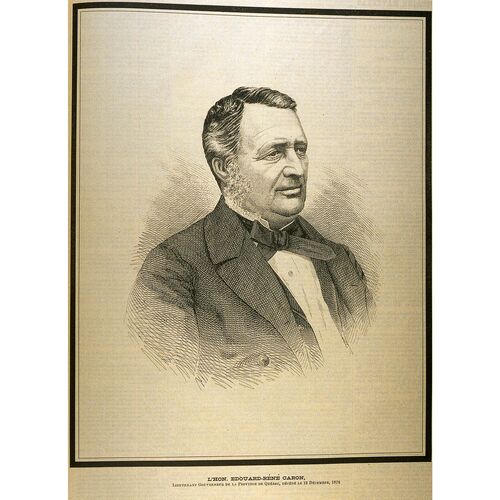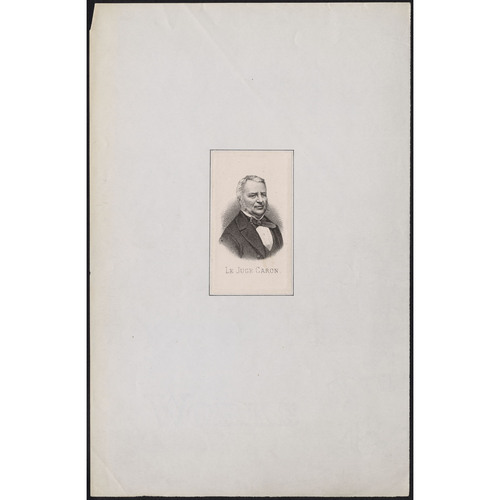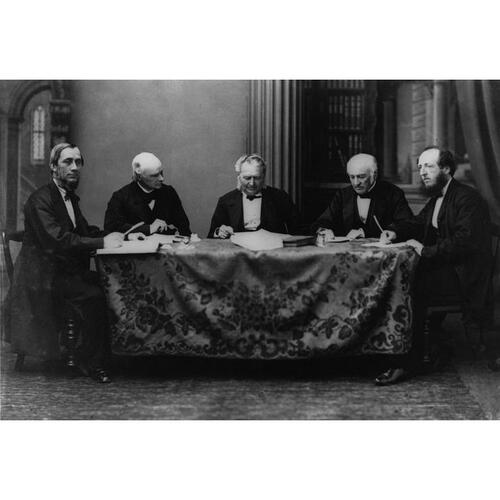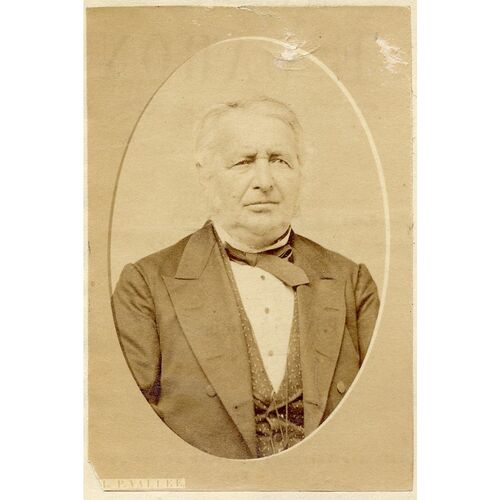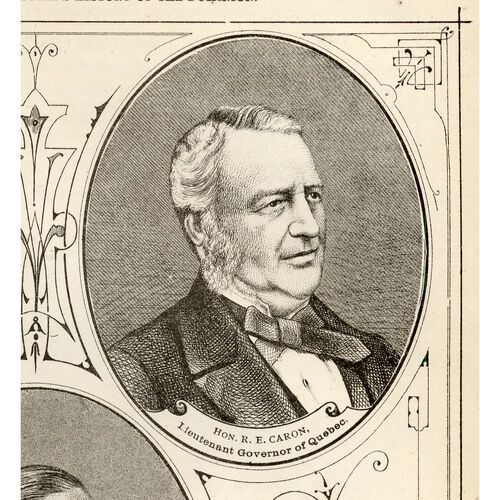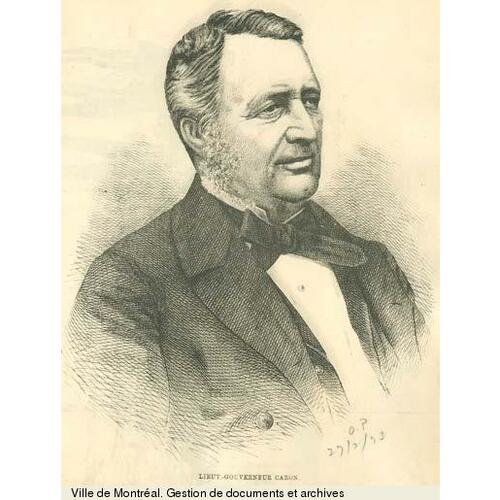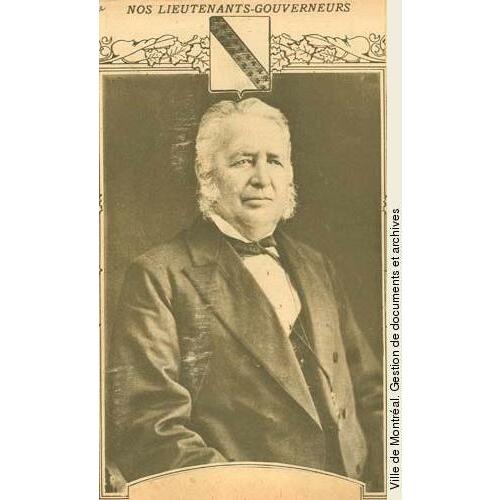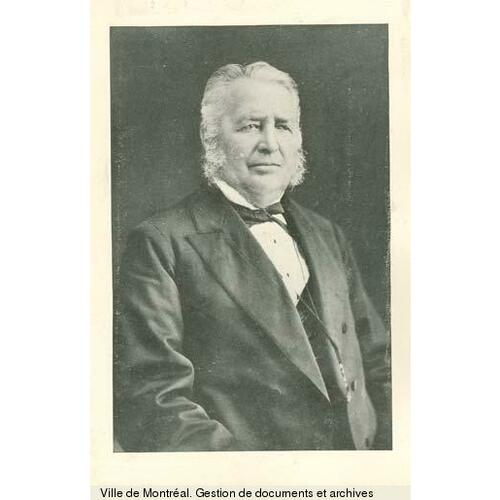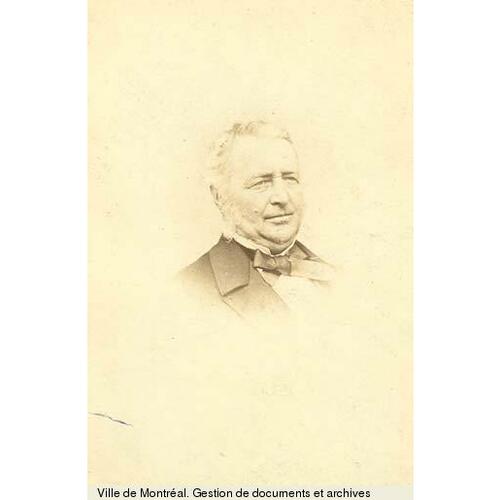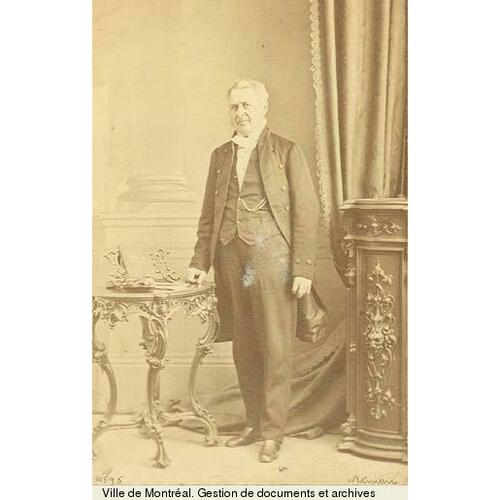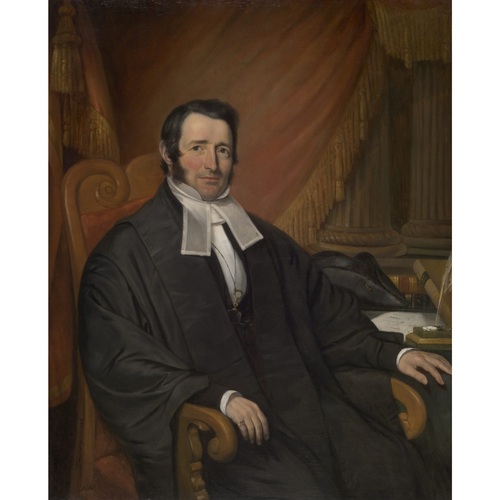CARON, RENÉ-ÉDOUARD, jurist, politician, second lieutenant governor of Quebec; b. 21 Oct. 1800 at Sainte-Anne-de-Beaupré, L.C., son of Élisabeth Lessard and Augustin Caron, a well-to-do farmer and mha for Lower Canada; d. 13 Dec. 1876 at Quebec.
René-Édouard Caron was educated at the college of Saint-Pierre-de-la-Rivière-du-Sud (Montmagny County), where the rudiments of Latin were taught; with this preparation he was admitted to the Petit Séminaire of Quebec in September 1813 as a boarder. He took the full classical course there, and left in 1820 after two years of philosophy. He studied law in André-Rémi Hamel’s office, was called to the bar on 7 Jan. 1826, and carried on his profession at Quebec. There he was not long in building up a good reputation as a jurist, at the same time acquiring a fairly well-paying clientele. In 1844 he went into partnership with Louis de Gonzague Baillargé*, who had studied under him; six years later the two lawyers were jointly appointed lawyers of the city of Quebec. The archives of the Petit Séminaire of Quebec also show that Caron was legal adviser to his Alma Mater. The firm of Caron et Baillargé was dissolved when Caron was appointed judge of the Superior Court in 1853.
It was by way of municipal institutions that Caron entered politics. On 31 March 1831 the House of Assembly of Lower Canada passed the bill that incorporated the city of Quebec and conferred on it the right to administer itself through an elected body. This law received royal sanction on 5 June 1832 (1 Wm IV, c.52). The city was divided into 10 wards, each having the right to elect two councillors. The councillors were to choose the mayor from among themselves at their first meeting. The new law was to remain in force until 1 May 1836. The first elections took place in 1833, and Caron became one of the representatives for the Palais district. Elzéar Bédard* was elected mayor, but in March 1834 the majority of the councillors voted in favour of Caron. He became second mayor of Quebec and remained so until 1 May 1836, when, the law not having been renewed, justices of the peace once more assumed direction of the city [see Hippolyte Dubord]. Quebec had a second experience of a municipal system in 1840, as the result of an ordinance of the Special Council (4 Vict., c.35) by virtue of which the governor appointed the mayor. Lord Sydenham [Thomson*] chose Caron, and the latter was elected at the end of two years, when the office again became an elective one. He relinquished it in 1846.
In the summer of 1834, during the period of Caron’s first administration, cholera ravaged the town of Quebec and claimed more than 2,000 victims. He organized the struggle against the epidemic and was not afraid to expose himself to the disease. He was again mayor when two successive fires, in May and June 1845, destroyed the greater part of the town. Appointed chairman of the relief committee, he gave proof of firm devotion to duty and great organizing ability.
In 1834 Caron was elected mha by acclamation, for the Upper Town of Quebec, and from the beginning he was one of the French Canadian moderate liberals in the assembly of Lower Canada. He adopted the ideas defended by Étienne Parent in Le Canadien and was not slow to oppose the radical wing led by Louis-Joseph Papineau. Though he voted for the Ninety-two resolutions, he was soon identified with a small group of assemblymen, “the Quebec party,” which favoured a policy of conciliation. Caron and his friends tried to give concrete form to this policy in March 1836 when Papineau was refusing to agree to vote supplies. Caron voted against the French Canadian leader, who triumphed in his no-compromise policy. On 6 March a large number of Caron’s electors presented an address to Papineau approving his action, and by implication censuring their representative, and Caron judged it necessary to resign.
On 22 Aug. 1837 the Colonial Office authorized the governor, Lord Gosford [Acheson*], to appoint at one time ten legislative councillors, including seven French Canadians. Caron was one. The council was to disappear following the suspension of the constitution in 1838. In 1837 Caron refused to sit on the Executive Council. In January 1840, when the plan of union that had been adopted by the legislature of Upper Canada became known, Caron was one of the most active members at Quebec of the movement led by John Neilson* which opposed it. During a meeting held on 17 January, at the home of the notary Louis-Édouard Glackmeyer*, the first stages in the struggle were organized. A few days later Caron took part in a popular gathering at which a petition “against Union and for the constitution of 1791” was read. With Étienne Parent and François-Xavier Garneau*, he was a member of a committee of some 40 prominent citizens who in April managed to collect 38,928 signatures against the proposed union; a Quebec merchant, Vital Têtu, agreed to present them to the British parliament. The new constitution was none the less adopted, and ratified by Queen Victoria on 23 July 1840. In common with the majority of French Canadians, Caron deplored the new regime, but he had to accept it and before long was participating in its institutions. On 14 June 1841 he was appointed a member of the Legislative Council of United Canada, and was its speaker from 8 Nov. 1843 to 19 May 1847, and from 11 March 1848 to 14 Aug. 1853.
Caron took over as speaker of the council from Robert Sympson Jameson*, who had resigned in protest against the decision, backed by the government and accepted by parliament, to move the seat of the capital from Kingston to Montreal. The choice of Caron by Governor Sir Charles Theophilus Metcalfe*, who had first bargained with Peter McGill* and John Neilson, was initially regarded by the government of Louis-Hippolyte La Fontaine* and Robert Baldwin* as another move taken by the governor without consulting his ministers, but it was rather difficult for La Fontaine to oppose it because of the personal qualities of Caron, whom La Minerve, on 9 Nov. 1843, called “one of ours.”
The 10-month break in Caron’s speakership was occasioned by his taking part in political negotiations in 1845, 1846, and 1847. The negotiations, which aroused much strong feeling at the time, resulted from the desire to introduce Lower Canadian representatives into the Tory government, and were indeed the prelude to the recognition of responsible government in the Province of Canada. Already, on 10 March 1844, Denis-Benjamin Viger*, who was attempting to form a ministry following the resignation of the La Fontaine–Baldwin government, had offered Caron the post of attorney general for Canada East. He would have had to seek election to the assembly, but he was promised that if defeated he could resume his seat on the Legislative Council. Caron refused the offer. He was nevertheless considered a moderate who was easier to deal with than La Fontaine. At the beginning of July at Quebec, and at the beginning of August at Montreal, the first talks took place between Caron and William Henry Draper, who was regarded as a Conservative and on the whole opposed to La Fontaine’s Lower Canadian Reformers. Draper made known to Caron his wish that other French Canadians as well as those who were in it already would join the administration. He is thought to have mentioned Augustin-Norbert Morin* in particular, expressly ignoring La Fontaine because of the personal difficulties between the latter and Governor Metcalfe. Caron, loyal to his moderate sentiments, agreed to serve as intermediary, but it was not until 8 September that he wrote to La Fontaine to convey to him Draper’s offers of some portfolios for the Lower Canadian Reformers. Caron ended his letter with these revealing lines: “I must tell you that in my opinion our present situation cannot last. What we are offered is little enough, but it might be the beginning of something better. It is very possible that I see things wrongly, but it seems to me that this opening is well worth thinking about; I am informing you of it for this reason, so that you may consider it and be free to act, but the matter should be dealt with carefully.” Two days later La Fontaine replied; his letter, according to historian Thomas Chapais*, “constitutes a document of capital importance for the constitutional history of this period.” “What is proposed to us,” wrote La Fontaine, “is a repudiation of the principle of responsibility, in so far as it applies to Lower Canada. Since Mr Draper admits that the Lower Canadian section of the ministry does not represent Lower Canada, why keep it? Why not, in accordance with your principles, form a new administration for Lower Canada, with the help of some one who would be instructed to do it constitutionally?” On 17 September Caron wrote to Draper, to convey to him what could be regarded as La Fontaine’s refusal, and in his letter he was one of the first to state what was to be recognized later as the principle of the “double majority.” “The principle has been established,” he wrote, “that the direction of affairs should be in the hands of the two dominant parties in each of the sections of the province, that the government should not run Lower Canada by means of a majority obtained from Upper Canada, nor should it impose laws on the majority in Upper Canada as a result of the assistance given to it by Lower Canada, and that a government should last only so long as it is supported by a majority in each of the sections of the province.” The negotiations went on and ended fruitlessly in November 1845, when Draper informed Caron that, as Metcalfe felt obliged by illness to relinquish his post, the situation had changed, from which we may presume that the governor was not unacquainted with the actions of the Upper Canada politician.
At the beginning of April 1846 the Draper-Caron negotiations, which had been more or less secret, were the subject of a parliamentary debate during which La Fontaine read out all the correspondence between Draper, Caron, and himself: this conduct cast a chill on the relations between Caron and La Fontaine. In Dix ans au Canada de 1840 à 1850 . . . , Antoine Gérin-Lajoie* wrote: “What some of M. Caron’s friends regretted, when all the correspondence was published, was to see that in a letter to Mr Draper, dated 8 Sept. 1845, he showed himself desirous of seeing a reaction in favour of Sir Ch. Metcalfe’s government, a feeling that he concealed from M. La Fontaine. The latter could not but say publicly that if he had been aware of this letter his correspondence with M. Caron would have been discontinued immediately.”
In August 1846, two months after Viger’s resignation, Draper tried again, but unsuccessfully, to persuade Caron and Morin to enter a coalition analogous to the one he had proposed the preceding year. In a letter addressed to La Revue canadienne on 28 Aug. 1846, Morin wrote: “I must say unreservedly, on the subject of the recent negotiations between the provincial government on the one hand and M. Caron and myself on the other, that in this whole affair the steps taken by M. Caron, and my own, have been as honourable as I desired my own to be.”
The third attempt at negotiations with Caron took place in April 1847, when Lord Elgin [Bruce*], who had been appointed governor the preceding year, sought to regulate the strange situation whereby French Canadians were represented in the government only by Denis-Benjamin Papineau*, to whom the majority of Lower Canadian mlas were hostile. Papineau and William Cayley*, the inspector general in the government, offered Caron the presidency of the Executive Council. The latter nearly succumbed to the invitation, but he seems to have been prevented from doing so by the advice of his friend Morin, and by the desire to see La Fontaine come to power, as is revealed by a letter dated 11 April 1847 from Thomas Cushing Aylwin to La Fontaine: “I sincerely believe that Caron wants to do something worth while, and that he desires to see you recalled to power.”
However that may be, Caron was relieved of the speakership of the Legislative Council, after he had been made to understand that the post had to be held by a politician who enjoyed the government’s confidence, and he was replaced by Peter McGill. In the following session, in June 1847, Caron made a long speech in support of a series of resolutions put forward by John Neilson, in which it was argued that the French population was not sufficiently represented in the cabinet. He recalled all the dealings in which he had been involved, and concluded: “I am certain I have done nothing for which I should lose my seat; if I can reproach myself with anything, it is that I put my trust in the ministry. If the government had acted in this way for the good of the country, or even if it had acted in a polite manner, I should have been satisfied; but so long as it will not show that it had good reasons to treat me as it did, I shall say that its conduct was unjustifiable. When I accepted the position of Speaker of the Council, I stipulated that it should not be a political one. For four years I gave up my profession, and I consider that the ministry has no right to take this office from me without offering me what it gives to every official of the government who is deprived of his employment.”
During the summer after the 1847 session a political association was formed at Quebec called the “Comité constitutionnel de la réforme et du progrès,” and Caron was elected president of it. At the beginning of November the association launched a manifesto against the government; one of its resolutions demanded that the chief advisers of the governor should be “men enjoying the confidence of the people’s representatives.” In the elections of December 1847, which ended at the beginning of January 1848, the Reform party obtained a majority in the two parts of the country. Caron recovered his post as speaker of the Legislative Council, and at the same time entered the La Fontaine–Baldwin ministry. In the 1849 session he was among those in the upper house who warmly supported the rebellion losses bill. On the occasion of a ministerial reshuffle in November 1849, Caron ceased to be the representative for the Quebec region and was replaced by a Quebec lawyer, Jean Chabot*, as chief commissioner of public works. However, he remained speaker of the Legislative Council. A few weeks before, he had signed the loyalist manifesto, published by La Minerve on 15 October, which opposed the Annexation Manifesto; the loyalist manifesto began by the following declaration of faith: “Sincerely attached to the institutions that the mother country has recently recognized, and convinced that these institutions are enough to assure us, through wise and judicious legislation, of a prompt and effective remedy for all the wrongs of which our province may complain, we believe it our duty to protest without delay, publicly and solemnly, against the opinions expressed in that document [the Annexation Manifesto].”
On 28 Oct. 1851, Caron, still in his capacity as speaker of the Legislative Council, entered the government of Francis Hincks* and Morin. He remained in it until 15 Aug. 1853, when he was appointed judge of the Superior Court to replace the late Jean-Baptiste-Édouard Bacquet. On 29 Jan. 1855 he became a judge of the Court of Appeal, following the death of Judge Philippe Panet*.
Judge Caron was a member of the Special Court which was created under the authority of the seigneurial act of 1854, and presided over by the chief justice, Louis-Hippolyte La Fontaine. On 11 March 1856, with other judges of the Court of Appeal and the Superior Court, he gave his verdict on the legal problems that had been submitted to him. Each judge had the right to formulate his observations separately, which Judge Caron did; his remarks were published in 1856 in the Lower Canada Reports; seigniorial questions. In this collection he made a fairly detailed study of three problems: the nature and extent of the right of ownership of the local seigneurs over their fiefs and seigneuries; the nature and extent of their right of banalité; the ownership of rivers and running water, whether navigable or not.
Caron’s name has remained closely linked with the codification of civil law in Lower Canada. On 27 April 1857 George-Étienne Cartier introduced before the Legislative Assembly of United Canada the “Act to provide for the Codification of the Laws of Lower Canada relative to Civil matters and Procedure.” The bill became law on 10 June (20 Vict., c.43). It provided for the appointment by the governor of three persons as commissioners, to “reduce into one code to be called the Civil Code of Lower Canada, those provisions of the Laws of Lower Canada which relate to Civil Matters and are of a general and permanent character, whether they relate to Commercial Cases or to those of any other nature.” Once this task was completed, the commissioners were to reduce to “another Code, to be called the Code of Civil Procedure of Lower Canada, those provisions of the Laws of Lower Canada which relate to Procedure in Civil Matters and Cases, and are of a general and permanent character.” The two codes were to be patterned as far as possible on the structure of the French codes “known as the Code Civil, the Code de Commerce, and the Code de Procédure Civile.” The preamble to the act recalled the reasons for undertaking the codification. The civil laws in force in Lower Canada derived for the most part from the Custom of Paris, which had been applied in New France and of which the Quebec Act had ensured the continuance. These laws had, however, been modified by laws of English origin, so much so that there were not always good comparable versions in the two languages utilized before the courts. France, by codifying its law at the beginning of the century, had set an example for Lower Canada, as had Louisiana in its last civil code, adopted in 1825. Moreover, the French codification had suppressed the commentaries pertaining to those laws that pre-dated the Revolution, and in certain cases it seemed necessary to modify the old rules.
On 28 Nov. 1857 Cartier first approached the chief justice of Lower Canada, Louis-Hippolyte La Fontaine, to ask him to direct the commission, but La Fontaine refused: “there are too strong reasons against it; the first, the only one I need give, is the state of my health.” On 4 Feb. 1858 three commissioners were appointed by the government: René-Édouard Caron, Augustin-Norbert Morin, and Charles Dewey Day*, the latter two being judges of the Superior Court. In the letters of appointment the provincial secretary asked them to devote all their time to the task of codification, starting from 1 April, which meant that they had to give up the cases they had heard. Judge Caron was not officially appointed president of the commission, but he acted as such. The commissioners met for the first time at Quebec, on 20 May 1858, and were authorized to rent an office in a house belonging to Caron. On 10 June another meeting took place “to determine the best plan to follow,” and the work was apportioned between the commissioners and the secretaries.
The appointment of Caron touched off a brief controversy, reported in the Quebec papers of March 1859. The judge claimed that he had agreed to be a member of the commission only on condition that he could deliver judgements in the cases he had heard. His two colleagues maintained that he did not have the right to sit, and he finally yielded to their arguments. When Morin died in 1865, Joseph-Ubalde Beaudry replaced him as commissioner, and Louis-Siméon Morin succeeded Beaudry in the post of secretary. In 1862 Thomas Kennedy Ramsay*, a secretary of the commission, was dismissed from his post for political reasons, and was replaced by Thomas McCord*.
Caron drafted “Notes on the plan to be followed in the preparatory work of codification,” but Judge Day was entrusted with writing the first report, dealing with obligations. On 12 Oct. 1861 the commissioners submitted it to the government. The other reports appeared at intervals until 25 Nov. 1864, at which date the report on commercial law was delivered. The codifiers’ recommendations were then brought before parliament by the government, and were the object of a law adopted in 1865 (29 Vict., c.41). Caron and his colleagues next devoted their attention to drafting the code of civil procedure, which came into force on 28 June 1867. The two codes were not solely Caron’s work, but of the codifiers it was certainly he who by his knowledge of law and the equitable quality of his judgement left the deepest imprint upon them.
Caron then resumed his duties as a judge, and on 14 Feb. 1873 was appointed lieutenant governor of Quebec in succession to Narcisse-Fortunat Belleau*, the first holder of the position. He took as his motto the following Latin words, “suaviter in modo fortiter in re.” In this office he acquitted himself with great dignity. He gave the residence of Spencer Wood, which his predecessor had hardly lived in, an air of vice-regal grandeur. A pious man, he decided to establish a chapel there, and mass was celebrated in it for the first time on 23 Oct. 1873. Caron died on 13 Dec. 1876, and his funeral took place in the basilica of Quebec on 20 December. The papers were happy to stress that the city of Quebec had not witnessed the funeral of a head of state for over a century. The funeral oration was delivered by the vicar general Thomas-Étienne Hamel, who recalled the piety of the deceased and emphasized that at Spencer Wood “the evening prayer and the rosary were recited by the lieutenant governor,” probably as it was done at Sainte-Anne-de-Beaupré during the young peasant’s childhood. Caron had remained deeply attached to his native village, a celebrated place of pilgrimage, and on 26 July 1875, not long before his death, he had presented a processional banner to the church of Sainte-Anne-de-Beaupré in the name of several subscribers, and in the presence of 7,000 pilgrims. He was buried in Belmont cemetery.
On 10 July 1865 Caron had received from Université Laval the degree of doctor of laws honoris causa. On 24 Nov. 1875 he had been promoted to the rank of grand cross of the order of St Gregory the Great. On 20 June 1848 he had been made a queen’s counsel. He had been an officer in the militia, becoming a lieutenant on 6 Dec. 1825 and a captain in the Quebec artillery on 30 Dec. 1837. On 15 Sept. 1853 the Société Saint-Jean-Baptiste of Quebec had thanked him for the important services he had rendered as its second president from 1842 to 1852.
On 16 Sept. 1828, at Notre-Dame de Québec, Caron had married Marie-Vénérande-Joséphine Deblois, daughter of Joseph Deblois and Marie-Vénérande Ranvoyzé. They had several children, including Joseph-Philippe-René-Adolphe*, a minister in the governments of John A. Macdonald*, John Joseph Caldwell Abbott*, and Mackenzie Bowell*; Corine, wife of Sir Charles Fitzpatrick*; and Marie-Joséphine, wife of Jean-Thomas Taschereau* and mother of Louis-Alexandre*, the future prime minister of Quebec.
Among the secondary personages of the union period, Caron occupied one of the first places. To a certain extent, he represented moderate sentiments in his region, with his sincere desire to reach compromises in order to benefit from the union, but he never yielded on the principles he regarded as essential. He was one of those who brought about responsible government, and, furthermore, his legal knowledge enabled him to carry through to a successful conclusion the important task of codification. Louis-Philippe Turcotte seems to have aptly expressed the judgement of his contemporaries when he wrote at the time of his death: “His career has been useful to his country. He has always followed a straight course, guided solely by his conscience and his conception of duty.”
[The Caron papers are found in the ANQ and the ASQ, Fonds Caron, 1–4; mss, 764–817. They consist of a certain number of private and official letters, account books, and especially documents he used in the codification. A concise inventory of the latter is found in a study by Professor J. E. C. Brierley, “Quebec’s civil law codification; viewed and reviewed,” McGill Law Journal (Montreal), XIV (1968), 521–89.
The correspondence between Caron, Draper, and La Fontaine is published: Correspondance entre l’Hon. W. H. Draper et l’Hon. R.-É. Caron; et entre l’Hon. R.-É. Caron, et les honorables L.-H. Lafontaine et A.-N. Morin, dont il a été question dans un débat récent dans l’Assemblée législative (Québec, 1846). It also appeared in English: Correspondence between the Hon. W. H. Draper & the Hon. R. E. Caron . . . (Montreal, 1846).
No real biography of Caron has been written. The one published by the Journal de Québec on 14 Dec. 1876, the day after the death of the lieutenant governor, over the initials L.T. was only a copy, with a few variants, of a pamphlet by L.-P. Turcotte, L’honorable R.-É. Caron, lieutenant-gouverneur de la province de Québec (Québec, 1873). The biography of Caron in Le Jeune, Dictionnaire, I, is often referred to but is quite incomplete. However it is patterned after a more complete biography, found in Dent, Canadian portrait gallery, I.
General works on the union are full of material on Caron: Chapais, Histoire du Canada, V, VI; Dent, Last forty years; Antoine Gérin-Lajoie, Dix ans au Canada de 1840 à 1850; histoire de l’établissement du gouvernement responsable (Québec, 1888); Turcotte, Canada sous l’Union; Monet, Last cannon shot. The last of these is the most recent and gives a more balanced view of Caron. j.-c.b.]
Cite This Article
J.-C. Bonenfant, “CARON, RENÉ-ÉDOUARD,” in Dictionary of Canadian Biography, vol. 10, University of Toronto/Université Laval, 2003–, accessed April 1, 2025, https://www.biographi.ca/en/bio/caron_rene_edouard_10E.html.
The citation above shows the format for footnotes and endnotes according to the Chicago manual of style (16th edition). Information to be used in other citation formats:
| Permalink: | https://www.biographi.ca/en/bio/caron_rene_edouard_10E.html |
| Author of Article: | J.-C. Bonenfant |
| Title of Article: | CARON, RENÉ-ÉDOUARD |
| Publication Name: | Dictionary of Canadian Biography, vol. 10 |
| Publisher: | University of Toronto/Université Laval |
| Year of revision: | 1972 |
| Access Date: | April 1, 2025 |


![[L'Honorable R. E. Caron] [image fixe] / L. P. Vallée (Louis Prudent) Original title: [L'Honorable R. E. Caron] [image fixe] / L. P. Vallée (Louis Prudent)](/bioimages/w600.3466.jpg)
